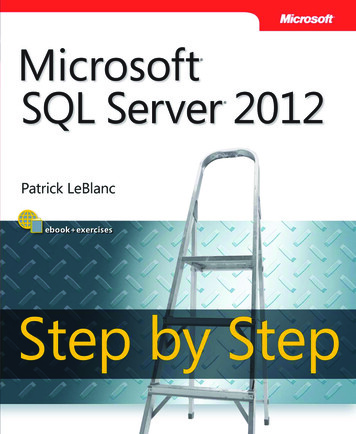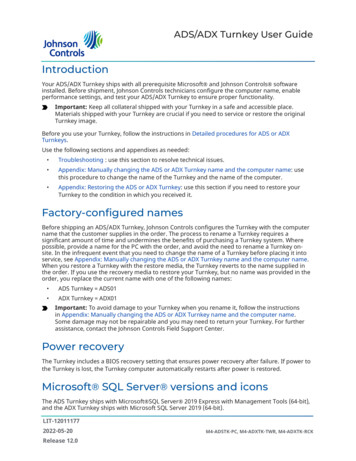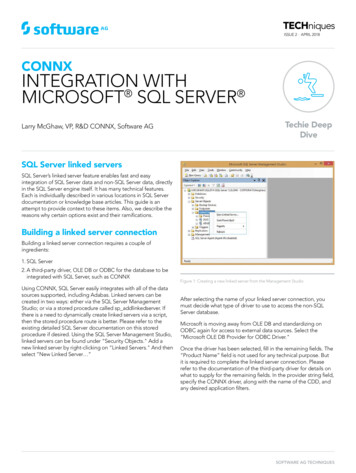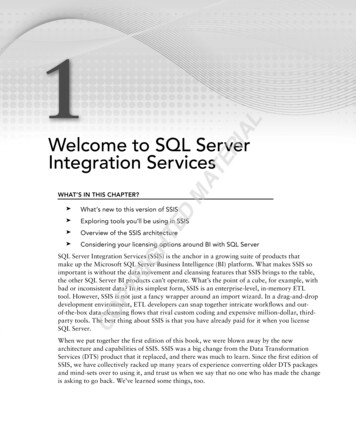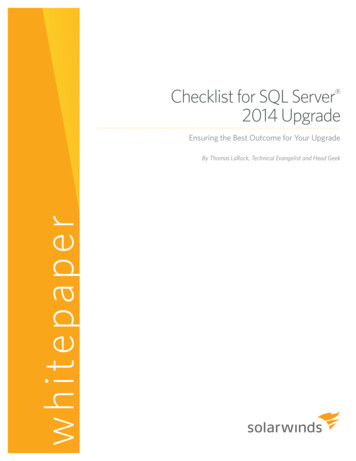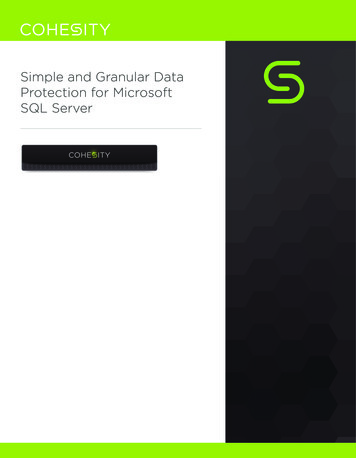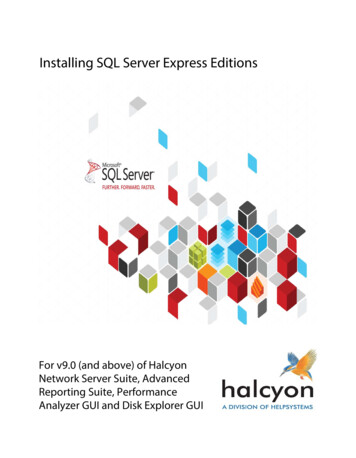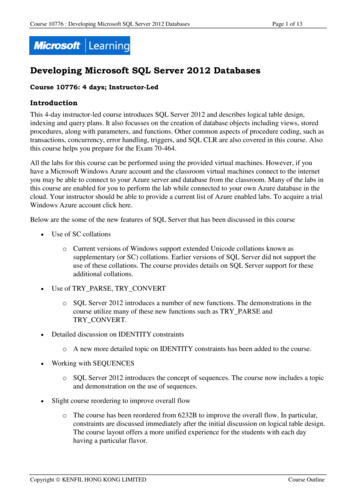
Transcription
Course 10776 : Developing Microsoft SQL Server 2012 DatabasesPage 1 of 13Developing Microsoft SQL Server 2012 DatabasesCourse 10776: 4 days; Instructor-LedIntroductionThis 4-day instructor-led course introduces SQL Server 2012 and describes logical table design,indexing and query plans. It also focusses on the creation of database objects including views, storedprocedures, along with parameters, and functions. Other common aspects of procedure coding, such astransactions, concurrency, error handling, triggers, and SQL CLR are also covered in this course. Alsothis course helps you prepare for the Exam 70-464.All the labs for this course can be performed using the provided virtual machines. However, if youhave a Microsoft Windows Azure account and the classroom virtual machines connect to the internetyou may be able to connect to your Azure server and database from the classroom. Many of the labs inthis course are enabled for you to perform the lab while connected to your own Azure database in thecloud. Your instructor should be able to provide a current list of Azure enabled labs. To acquire a trialWindows Azure account click here.Below are the some of the new features of SQL Server that has been discussed in this course Use of SC collationso Current versions of Windows support extended Unicode collations known assupplementary (or SC) collations. Earlier versions of SQL Server did not support theuse of these collations. The course provides details on SQL Server support for theseadditional collations. Use of TRY PARSE, TRY CONVERTo SQL Server 2012 introduces a number of new functions. The demonstrations in thecourse utilize many of these new functions such as TRY PARSE andTRY CONVERT. Detailed discussion on IDENTITY constraintso A new more detailed topic on IDENTITY constraints has been added to the course. Working with SEQUENCESo SQL Server 2012 introduces the concept of sequences. The course now includes a topicand demonstration on the use of sequences. Slight course reordering to improve overall flowo The course has been reordered from 6232B to improve the overall flow. In particular,constraints are discussed immediately after the initial discussion on logical table design.The course layout offers a more unified experience for the students with each dayhaving a particular flavor.Copyright KENFIL HONG KONG LIMITEDCourse Outline
Course 10776 : Developing Microsoft SQL Server 2012 Databases Page 2 of 13Use of THROW and comparisons to RAISERRORo SQL Server 2012 enhances the available error-handling options in T-SQL. The moduleon error-handling has been expanded to show how to use THROW in place ofRAISERROR and also to show how to rethrow errors (including system errors) withinCATCH blocks using the THROW statement. Full-globe and arc support in spatialo SQL Server 2012 adds support for geography data-type objects that span more than asingle hemisphere. The course discusses the new full globe support and along with newsupport for curved arc objects. Customizable nearness in full-texto The course covers how full-text indexing in SQL Server 2012 offers a morecustomizable and flexible proximity operation than earlier versions of SQL Server.At Course CompletionAfter completing this course, students will be able to: Introduce the entire SQL Server platform and its major tools. It will cover editions, versions,basics of network listeners, and concepts of services and service accounts.Determine appropriate data types to be used when designing tables, convert data between datatypes, and create alias data types.Be aware of good design practices regarding SQL Server tables and be able to create tablesusing T-SQL. (Note: partitioned tables are not covered).Implement PRIMARY KEY, FOREIGN KEY, DEFAULT, CHECK and UNIQUE constraints,and investigate cascading FOREIGN KEY constraints.Determine appropriate single column and composite indexes strategies.Create tables as heaps and tables with clustered indexes. Also consider the design of a tableand suggest an appropriate structure.Read and interpret details of common elements from execution plans.Design effective non-clustered indexes.Design and implement viewsDesign and implement stored procedures.Work with table types, table valued parameters and use the MERGE statement to create storedprocedures that update data warehouses.Design and implement functions, both scalar and table-valued. (Also describe where they canlead to performance issues).Perform basic investigation of a deadlock situation and learn how transaction isolation levelsaffect application concurrency.Use both traditional T-SQL error handling code and structured exception handling.Design and implement DML triggersLearn appropriate uses for SQL CLR integration and implement an existing .NET assemblywithin SQL Server.Store XML data and schemas in SQL Server.Perform basic queries on XML data in SQL Server.Work with the GEOGRAPHY and GEOMETRY data typesImplement and query a full-text index.Copyright KENFIL HONG KONG LIMITEDCourse Outline
Course 10776 : Developing Microsoft SQL Server 2012 DatabasesPage 3 of 13AudienceThe primary audience for this course is IT Professionals who want to become skilled on SQL Server2012 product features and technologies for implementing a database.PrerequisitesIn addition to their professional experience, students who attend this training should already have thefollowing technical knowledge: Knowledge of writing T-SQL queries.Knowledge of basic relational database concepts.Students who attend this training can meet the prerequisites by attending the following courses,or obtaining equivalent knowledge and skills:10774A: Writing T-SQL Queries for Microsoft SQL Server 2012Course OutlineModule 1: Introduction to SQL Server 2012 and its ToolsetThis module stresses on the fact that before beginning to work with SQL Server in either adevelopment or an administration role, it is important to understand the overall SQL Server platform.In particular, it is useful to understand that SQL Server is not just a database engine but it is a completeplatform for managing enterprise data.Lessons Introduction to the SQL Server Platform Working with SQL Server Tools Configuring SQL Server ServicesLab: Introduction to SQL Server and its Toolset Verifying SQL Server Component Installation Altering Service Accounts for New Instance Enabling Named Pipes Protocol for Both Instances Creating an Alias for AdvDev Ensuring SQL Browser is Disabled and Configure a Fixed TCP/IP Port (Only if time permitsAfter completing this lesson, you will be able to: Describe the SQL Server Platform. Work with SQL Server Tools. Configure SQL Server Services.Copyright KENFIL HONG KONG LIMITEDCourse Outline
Course 10776 : Developing Microsoft SQL Server 2012 DatabasesPage 4 of 13Module 2: Working with Data TypesThis module explains how to use and convert data types. Also it focusses on how to work withspecialized data types, and character data types.Lessons Using Data Types Working with Character Data Converting Data Types Specialized Data TypesLab: Working with Data Types Choosing Appropriate Data Types Writing Queries With Data Type Conversions Designing and Creating Alias Data Types (Only if time permits)After completing this module, students will be able to: Work with data types. Work with character data. Convert between data types. Use specialized data types.Module 3: Designing and Implementing TablesThis module explains how to design, create, and alter tables. Also it focusses on working with schemas.Lessons Designing Tables Working with Schemas Creating and Altering TablesLab: Designing and Implementing Tables Improving the Design of Tables Creating a Schema Creating the TablesAfter completing this module, students will be able to: Design Tables. Work with Schemas.Copyright KENFIL HONG KONG LIMITEDCourse Outline
Course 10776 : Developing Microsoft SQL Server 2012 Databases Page 5 of 13Create and Alter Tables.Module 4: Ensuring Data Integrity through ConstraintsThis module explains how to enforce data integrity, and implement domain integrity to maintain highquality data. Also it focusses on implementing Entity and Referential Integrity.Lessons Enforcing Data Integrity Implementing Domain Integrity Implementing Entity and Referential IntegrityLab: Ensuring Data Integrity through Constraints Designing Constraints Testing the constraintsAfter completing this module, students will be able to: Explain the available options for enforcing data integrity and the levels at which they should beapplied. Implement domain integrity. Implement entity and referential integrity.Module 5: Planning for SQL Server 2012 IndexingThis module explains the core indexing concepts and effectiveness of each data type commonly usedin indexes.Lessons Core Indexing Concepts Data Types and Indexes Single Column and Composite IndexesLab: Planning for SQL Server Indexing Exploring existing index statistics Designing column orders for indexesAfter completing this module, students will be able to: Explain core indexing concepts. Describe the effectiveness of each data type common used in indexes. Plan for single column and composite indexes.Copyright KENFIL HONG KONG LIMITEDCourse Outline
Course 10776 : Developing Microsoft SQL Server 2012 DatabasesPage 6 of 13Module 6: Implementing Table Structures in SQL Server 2012This module explains how tables can be structured in SQL Server databases. Also it focusses ondesigning and working with clustered indexes.Lessons SQL Server Table Structures Working with Clustered Indexes Designing Effective Clustered IndexesLab: Implementing Table Structures in SQL Server Creating Tables as Heaps Creating Tables with Clustered Indexes Comparing the Performance of Clustered Indexes vs. HeapsAfter completing this module, students will be able to: Explain how tables can be structured in SQL Server databases. Work with clustered indexes. Design effective clustered indexes.Module 7: Reading SQL Server 2012 Execution PlansThis module explains how to design additional indexes. Also it focusses on how to read and interpretexecution plans.Lessons Execution Plan Core Concepts Common Execution Plan Elements Working with Execution PlansLab: Reading SQL Server Execution Plans Actual vs. Estimated Plans Identifying Common Plan Elements Querying Cost ComparisonAfter completing this module, students will be able to: Explain the core concepts related to the use of execution plans. Describe the role of the most common execution plan elements. Work with execution plans.Copyright KENFIL HONG KONG LIMITEDCourse Outline
Course 10776 : Developing Microsoft SQL Server 2012 DatabasesPage 7 of 13Module 8: Improving Performance through Nonclustered IndexesThis module explains how nonclustered indexes have the potential to significantly enhance theperformance of applications and how to use a tool that can help design these indexes appropriately.Lessons Designing Effective Nonclustered Indexes Implementing Nonclustered Indexes Using the Database Engine Tuning AdvisorLab: Improving Performance through Nonclustered Indexes Nonclustered index usage review Improving nonclustered index designs Working with SQL Server Profiler and Database Engine Tuning Advisor Designing nonclustered indexAfter completing this module, students will be able to: Design effective nonclustered indexes Implement nonclustered indexes Use the database engine tuning advisor to design indexesModule 9: Designing and Implementing ViewsThis module introduces Views, and explains how to create and manage Views. Also it focusses on theperformance consideration for Views.Lessons Introduction to Views Creating and Managing Views Performance Considerations for ViewsLab: Designing and Implementing Views Designing, Implementing and Testing the WebStock Views Designing and Implementing the Contacts View Modifying the AvailableModels ViewAfter completing this module, students will be able to: Explain the role of views in database development. Implement views.Copyright KENFIL HONG KONG LIMITEDCourse Outline
Course 10776 : Developing Microsoft SQL Server 2012 Databases Page 8 of 13Describe the performance related impacts of views.Module 10: Designing and Implementing Stored ProceduresThis module describes the potential advantages of the use of stored procedures along with guidelineson creating them.Lessons Introduction to Stored Procedures Working With Stored Procedures Implementing Parameterized Stored Procedures Controlling Execution ContextLab: Designing and Implementing Stored Procedures Creating stored procedures Creating a parameterized stored procedure Altering the execution context of stored proceduresAfter completing this module, students will be able to: Describe the role of stored procedures and the potential benefits of using them. Work with stored procedures. Implement parameterized stored procedures. Control the execution context of a stored procedure.Module 11: Merging Data and Passing TablesThis module reviews the techniques that provide the ability to process sets of data rather thanindividual rows. Also it focusses on how these techniques can be used in combination with TABLEparameter types to minimize the number of required stored procedure calls in typical applications.Lessons Using the MERGE Statement Implementing Table Types Using TABLE Types As ParametersLab: Passing Tables and Merging Data Creating a Table Type Using a Table Type Parameter Using a Table Type with MERGECopyright KENFIL HONG KONG LIMITEDCourse Outline
Course 10776 : Developing Microsoft SQL Server 2012 DatabasesPage 9 of 13After completing this module, students will be able to: Use the MERGE statement. Implement table types. Use TABLE types as parameters.Module 12: Designing and Implementing User-Defined FunctionsThis module explains how to design and implement user-defined functions that enforce business rulesor data consistency, and modify and maintain existing functions written by other developers.Lessons Overview of Functions Designing and Implementing Scalar Functions Designing and Implementing Table-Valued Functions Implementation Considerations for Functions Alternatives to FunctionsLab: Designing and Implementing User-Defined Functions Formatting Phone Numbers Modifying an Existing Function Resolve a Function-related Performance IssueAfter completing this module, students will be able to: Design and implement scalar functions. Design and implement table-valued functions. Describe implementation considerations for functions. Describe alternatives to functions.Module 13: Creating Highly Concurrent SQL Server 2012 ApplicationsThis module explains how to use transactions and the SQL Server locking mechanisms to meet theperformance and data integrity requirements of your applications.Lessons Introduction to Transactions Introduction to Locks Management of Locking Transaction Isolation LevelsCopyright KENFIL HONG KONG LIMITEDCourse Outline
Course 10776 : Developing Microsoft SQL Server 2012 DatabasesPage 10 of 13Lab: Creating Highly Concurrent SQL Server Applications Detecting Deadlockss Investigating Transaction Isolation LevelsAfter completing this module, students will be able to: Describe the role of transactions Explain the role of locks Manage locking Work with transaction isolation levelModule 14: Handling Errors in T-SQL CodeThis module explores T-SQL error handling, looks at how it has traditionally been implemented, andhow structured exception handling can be usedLessons Understanding T-SQL Error Handling Implementing T-SQL Error Handling Implementing Structured Exception HandlingLab: Handling Errors in T-SQL Code Replacing @@ERROR based error handling with structured exception handling Adding deadlock retry logic to the stored procedureAfter completing this module, students will be able to: Design T-SQL error handling Implement T-SQL error handling Implement structured exception handlingModule 15: Responding to Data Manipulation via TriggersThis module, explains what DML triggers are and how they enforce data integrity. Also it focusses onthe different types of triggers available, and how to define triggers in a database.Lessons Designing DML Triggers Implementing DML Triggers Advanced Trigger ConceptsLab: Responding to Data Manipulation via TriggersCopyright KENFIL HONG KONG LIMITEDCourse Outline
Course 10776 : Developing Microsoft SQL Server 2012 Databases Creating and Testing the Audit Trigger Improving the Audit TriggerPage 11 of 13After completing this module, students will be able to: Design DML triggers. Implement DML triggers. Explain advanced DML trigger concepts.Module 16: Implementing Managed Code in SQL Server 2012This module explains how to use CLR integrated code to create user-defined database objects that aremanaged by the .NET Framework.Lessons Introduction to SQL CLR Integration Importing and Configuring Assemblies Implementing SQL CLR IntegrationLab: Designing and Implementing Views Assessing Proposed CLR Code Implementing a CLR Assembly Implementing a CLR User-defined Aggregate and CLR User-defined Data TypeAfter completing this module, students will be able to: Explain the importance of SQL Server CLR Integration. Import and configure assemblies. Implement objects that have been created within .NET assemblies.Module 17: Storing XML Data in SQL Server 2012This module introduces XML and shows how XML data can be stored within SQL Server.Lessons Introduction to XML and XML Schemas Storing XML Data and Schemas in SQL Server Implementing the XML Data TypeLab: Storing XML Data in SQL Server Appropriate Usage of XML Data Storage in SQL Server Investigating the Storage of XML Data in VariablesCopyright KENFIL HONG KONG LIMITEDCourse Outline
Course 10776 : Developing Microsoft SQL Server 2012 Databases Investigating the use of XML Schema Collections Investigating the Creation of Database Columns Based on XMLPage 12 of 13After completing this module, students will be able to: Describe XML and XML schemas. Store XML data and associated XML schemas in SQL Server. Implement the XML data type within SQL Server.Module 18: Querying XML Data in SQL ServerThis module shows how XML data can be queried, including queries written in a language calledXQuery.Lessons Using the T-SQL FOR XML Statement Getting Started with XQuery Shredding XMLLab: Querying XML Data in SQL Server Learning to query SQL Server data as XML Writing a stored procedure returning XML Writing a stored procedure that updates using XMLAfter completing this module, students will be able to: Use the T-SQL FOR XML Statement. Work with basic XQuery queries. Shred XML to a relational form.Module 19: Working with SQL Server 2012 Spatial DataThis module introduces Spatial Data, and explains how to work with SQL Server Spatial Data Types.Lessons Introduction to Spatial Data Working with SQL Server Spatial Data Types Using Spatial Data in ApplicationsLab: Working with SQL Server Spatial Data Familiarity With Geometry Data Type Adding Spatial Data to an Existing TableCopyright KENFIL HONG KONG LIMITEDCourse Outline
Course 10776 : Developing Microsoft SQL Server 2012 Databases Page 13 of 13Business Application of Spatial DataAfter completing this module, students will be able to: Describe the importance of spatial data and the industry standards related to it. Explain how to store spatial data in SQL Server. Perform calculations on and query SQL Server spatial data.Module 20: Working with Full-Text Indexes and QueriesThis module introduces Full-Text Indexing and how to implement Full-Text Indexes in SQL Server.Lessons Introduction to Full-Text Indexing Implementing Full-Text Indexes in SQL Server Working with Full-Text QueriesLab: Working with Full-Text Indexes and Queries Implementing a full-text index Implementing a stoplist Creating a stored procedure to implement a full-text searchAfter completing this module, students will be able to: Describe why user interfaces in existing applications are not sufficient for end user searchneeds Implement full-text indexes in SQL Server Query SQL Server using full-text queriesCopyright KENFIL HONG KONG LIMITEDCourse Outline
Course 10776 : Developing Microsoft SQL Server 2012 Databases Page 1 of 13 . Learn appropriate uses for SQL CLR integration and implement an existing .NET assembly within SQL Server. . Configure SQL Server Services. Course 10776 : Developing Microsoft SQL Server 2012 Databases Page 4 of 13 .

